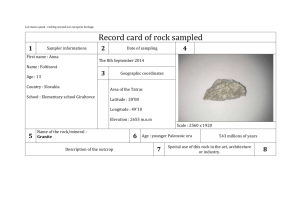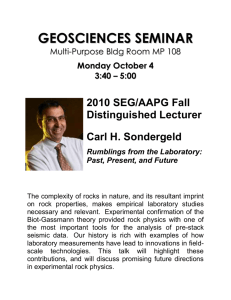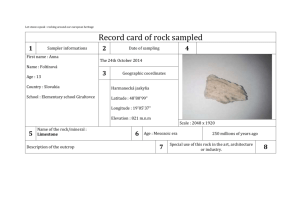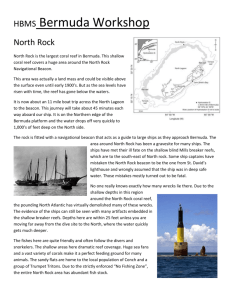GSA 2012 paper
advertisement
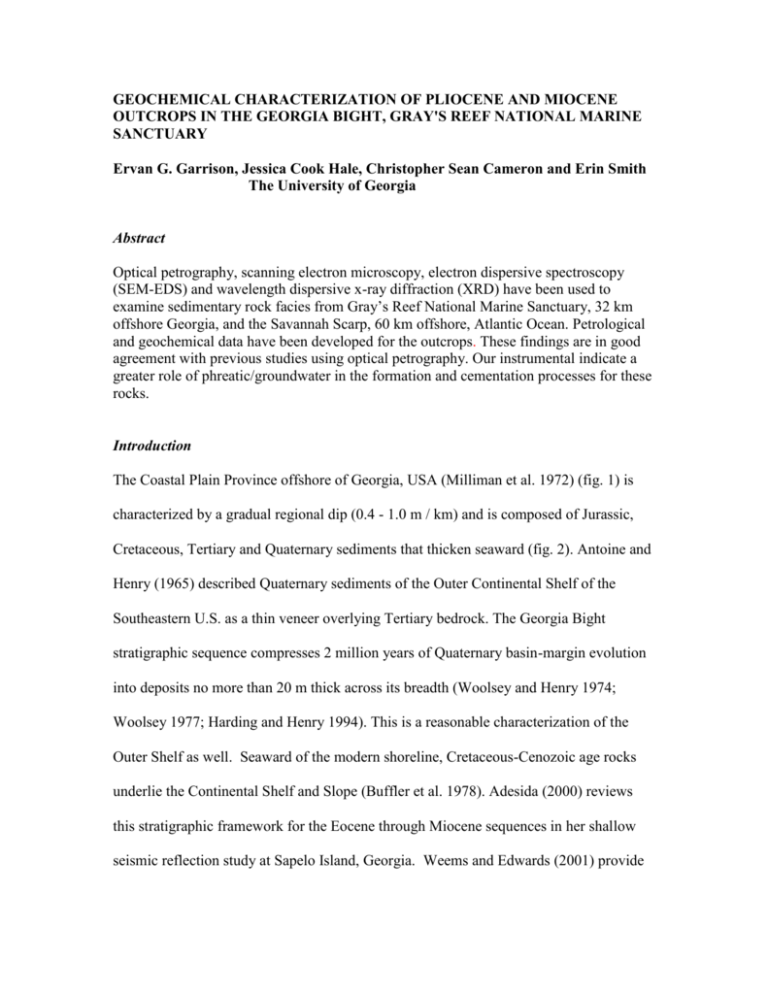
GEOCHEMICAL CHARACTERIZATION OF PLIOCENE AND MIOCENE OUTCROPS IN THE GEORGIA BIGHT, GRAY'S REEF NATIONAL MARINE SANCTUARY Ervan G. Garrison, Jessica Cook Hale, Christopher Sean Cameron and Erin Smith The University of Georgia Abstract Optical petrography, scanning electron microscopy, electron dispersive spectroscopy (SEM-EDS) and wavelength dispersive x-ray diffraction (XRD) have been used to examine sedimentary rock facies from Gray’s Reef National Marine Sanctuary, 32 km offshore Georgia, and the Savannah Scarp, 60 km offshore, Atlantic Ocean. Petrological and geochemical data have been developed for the outcrops. These findings are in good agreement with previous studies using optical petrography. Our instrumental indicate a greater role of phreatic/groundwater in the formation and cementation processes for these rocks. Introduction The Coastal Plain Province offshore of Georgia, USA (Milliman et al. 1972) (fig. 1) is characterized by a gradual regional dip (0.4 - 1.0 m / km) and is composed of Jurassic, Cretaceous, Tertiary and Quaternary sediments that thicken seaward (fig. 2). Antoine and Henry (1965) described Quaternary sediments of the Outer Continental Shelf of the Southeastern U.S. as a thin veneer overlying Tertiary bedrock. The Georgia Bight stratigraphic sequence compresses 2 million years of Quaternary basin-margin evolution into deposits no more than 20 m thick across its breadth (Woolsey and Henry 1974; Woolsey 1977; Harding and Henry 1994). This is a reasonable characterization of the Outer Shelf as well. Seaward of the modern shoreline, Cretaceous-Cenozoic age rocks underlie the Continental Shelf and Slope (Buffler et al. 1978). Adesida (2000) reviews this stratigraphic framework for the Eocene through Miocene sequences in her shallow seismic reflection study at Sapelo Island, Georgia. Weems and Edwards (2001) provide the most current description of coastal Georgia’s suite of nineteen unconformably bound Oligocene and Miocene, three Pliocene, and two Pleistocene stratigraphic units (Weems and Edwards 2001:7-15). FIGURES 1, 2 & 3 According to several sources, the Quaternary and Pliocene units of the Georgia Bight are both unconsolidated and consolidated clastic shallow-neritic sediments – mainly composed of suborthoquartzitic, fine-to-medium-grained sands overlying a so-called R2 seismic reflector described by Foyle (Henry and Hoyt 1967; Milliman et al. 1972; Huddleston 1988; Idris and Henry 1995; Henry and Idris 1992; Swift et al. 1972; Swift and Niedorada 1985; Gayes et al.1992; Foyle et al. 2004). In this study we have mapped and characterized, lithologically, late Tertiary and Quaternary sediments at three locations in the Georgia Bight – Gray’s Reef, a National Marine Sanctuary,a low exposure of low otcrops and shell beds about 30 km seaward of Sapelo Island and the Savannah Scarp, roughly 60 km further seaward. Our data support the above characterization with the exception of 'suborthoquartzitic'. All the rock sampled and analyzed for this paper was determined to be non-indurated calcarenite. Ages for Gray's Reef Outcrops The Satilla and Raysor Formations are two members of the suite of nineteen unconformably bound Oligocene and Miocene, three Pliocene, and two Pleistocene stratigraphic units (Weems and Edwards 2001:7-15) (Fig. 2). The Satilla formation is late Pleistocene in age (Garrison et al, 2008, Table 3). In both locations the upper Satilla formation sediments are capped by the exposed shell beds of significant thicknesses (> 3 m or more). Mapping of this coquina at Gray’s Reef led to the conclusion that the Pliocene Raysor facies had been exhumed during the present and past transgressions (Garrison, et al, 2008). Dating of the Raysor Formation as suggested by Huddleston (1988) is based on stratigraphy and equivalent lithology as Pliocene. That facies is both materially and timeequivalent to the Raysor (also referred to as the Duplin Formation). Woolsey (1977) identified this unit at Sapelo Island, 32 km landward today of Gray’s Reef. At Sapelo, it is - 18 m MSL beneath this barrier island (figs.1, 2). Using a reasonable value for dip, the unit would outcrop at - 22 m MSL or the mean average of the reef substrate. Based on planktonic foraminifera found in the Raysor, Huddleston (1988) assigns an age of early late Pliocene or 2-3Ma. The Satilla formation is composed of at least two provisional members, and in paleovalleys, such as that of Medway drainage, at J-reef (cf. Garrison, et al, 2008). Two consolidated facies consistently observed below the palimpset sand sheet are: (1) a weakly cemented Brown Sand and (2) a weak-to-moderately Concreted Shelly-Sand. These facies are observed in both cores and at outcrops at or near the -20 m isobath. A facies equivalent to the Brown Sand has been reported off South Carolina's Santee River (Sexton, et al. 1992:169). The Concreted Shelly-Sand is observed at Gray's Reef and JReef in bedded form (Gray's Reef) and outcrops (J-Reef). Within this member are assemblages of marine shell species, most notably Placopecten magellianicus. Direct dating of both inclusions (AMS) and sediment grains (OSL) has constrained the ages of these two facies to 31-43 ka (Brown Sand) and >42-44 ka, or M.I.S. 3 for the Concreted Shelly-Sand. Chronology has these two Satilla Formation elements in a conformable sequence. The Concreted Shelly-Sand is unconformable, at Gray's Reef, with the Raysor Formation (Pliocene). Dating of the puted Miocene rock of the Savannah Scarp is more speculative. We, like Sautter (Leslie Sautter, Personal Communication, 2010) assign a Miocene age to our sample following (See Jill C, COC thesis) and Henry (unpublished)(Fig.3). (FIGURE 3, Henry) Analytical Methods Field studies used both sediment coring and hand collection methods. Back In the laboratory, optical petrography was utilized to initially characterize polished thin sections of the materials. The thin sections were examined with an Olympus B-20 petrographic research microscope equipped with both transmitted/reflected polarized and Nomarski Differential phase contrast optics. The thin sections were, first, scanned w/ the 10X objective, plane polarized light (PPL), then, selected areas on the thin section were examined using so-called “cross” polarized light (XPL). Photomicrographs were taken with a digital camera equipped with a ScopeTronix ocular adapter. Energy dispersive x-ray spectroscopy (EDS) and wavelength dispersive x-ray spectroscopy (WDS) play invaluable roles in the characterization, compositional analysis, and understanding of the evolution of countless minerals. Utilizing the unique features of the mineral constituents, we can determine a general idea of their composition by bombardment with electrons and measurement of subsequent X-ray emission in the EDS, and a finer resolution is achieved through the use of wavelength regime-specific WDS. The Zeiss 1450 EP SEM/EDS at the Center for Advanced Ultrastructural Research at the University of Georgia (UGA) consists of a sample chamber pumped down to about 10-3 millibars (9.87 x 10-7 atm) to prevent atmospheric backscatter noise, with the electron beam and detector situated above. Samples are placed on an adjustable stage in the chamber, and moved under the electron beam (incident from the top) via an electric motor mechanism. The EDS apparatus contained in the setup is not shown. Representative SEM images were taken, as well as notable areas scanned with the EDS. The EDS proved invaluable in determining the general makeup and relative amounts of elements contained in each artifact and rock type. The SEM was used to obtain images of the structure of the samples. Access to an Oxford Instruments Field Emission-SEM (FE-SEM) system, during our study, equipped w/ both EBSD and EDX capability, allowed the detailed characterization of the rock. A JEOL 8600 scanning electron microprobe (EMPA) is one of the UGA Department of Geology’s cornerstone analytical instruments. The electron microprobe, in comparison to the SEM-EDS systems, uses a finely focused beam of high-energy electrons, typically 1-2 um in diameter, to excite a small volume of material (1-10 um3). The interaction of the electron beam with the atoms in the excited volume generates secondary and backscattered electrons used to image the sample, and characteristic x-rays measured to produce high precision, accurate quantitative analyses of the sample. Secondary electrons ejected from the surface atoms, and backscattered electrons scattered out of the sample reveal fine scale morphologic feature and compositional variation among the different constituents of the sample together with fine scale compositional zoning within individual mineral grains. The energy dispersive (EDS) X-ray detector detects a wide portion of the x-ray spectrum (Na-U) simultaneously, providing virtually instantaneous determination of elements present in the sample and rapid identification of the mineralogic phases present. Four wavelength dispersive (WDS) x-ray detectors were used to analyze elements ranging from F-U, and elements as light as B. Under ideal conditions, element concentrations as low as 100 ppm, could be measured. Finally, the XRD system used in this study is a Bruker D8-Advance. This X-ray diffractometer is a versatile tool for phase and structural analysis of powders, analysis of liquid samples (capillary and transmission modes) and reflectometry of thin layers. The system includes: (a) Vertical Theta-Theta Goniometer control with stepper motors and optical encoders providing smallest selectable stepsize; (b) a short ceramic Cu X-ray tube with fine long focus; (c) two exchangeable detectors of scattered X-rays: NaI scintillator type detector with low background (0.4 cps) and high dynamic range (up to 2x106) together with a Braun position-sensitive detector; (d) rotation-transmission, capillary and reflectrometry stages. The instrument is equipped with a wide range of crystallographic software for pattern simulations (NEWMOD, CrystalDiffract, and Wildfire), cell refinements (Rietveld refinement), crystal structure presentation (CrystalMaker), and the ICDD PDF2 data base. The raw diffractograms were processed using the DIFFRACplus EVA software by Bruker AXS. The Kα2 peaks and background noise were stripped and threshold sensitivity adjusted prior to performing a peak search to identify the major peaks in the diffractogram. Any significant peaks missed by the automated peak search were manually selected and added to the diffractogram record. Finally, potential mineral matches for each peak were identified with a general search option within the EVA software. Suspected minerals not included by the automated search were checked by conducting manual EVA searches for individual minerals. Peak intensity, 2θ, and dspacing were used to identify the most likely mineral(s) responsible for each peak. The 2θ and d-spacing of suspected mineral matches were then compared to known index values, and thereby verified or disqualified as a match, using Powder Diffraction Database Search software by Scintag, Inc. Results a. Gray’s Reef - The rock of Gray's Reef has been extensively characterized, in thin section, by Hunt (1974) and, again, by Harding and Henry (1994). This study has only confirmed those studies findings adding, only, spectroscopic data in the hope of adding further details. Harding and Henry (1994) presented petrological findings from hand samples collected in 1987 (4 samples) and another set of 9 hand samples taken by Georgia Department of Natural Resources (DNR) divers. The 1987 samples were from outcrops in the southern and southwestern areas of Gray's Reef National Marine Sanctuary while the DNR samples were concentrated in the northeast, northwest and southwest portions of the sanctuary. By comparison, our samples, with the exception of the Savannah Scarp rock, were collected in the northwest of the sanctuary, within a 200 meters radius (cf. fig. 2). Harding and Henry (1994) characterized the rocks in their study as slight-tocompact in terms of cementation and induration. They described the lithology as that of a calcareous dolomitic sandstone. Hunt (1974) differed by identifying the rock as a type sandy biomicrite. The difference, perhaps, lying in the proportion of clastic and carbonate present in the specific rocks. In the former, the quartz, feldspar(s), etc., tend to dominate in proportion. The Upper Terrace Ledge is a good example of the latter, where the sparse grains are embedded in a pervasive carbonate matrix (fig. 4). Where Hunt, Harding and Henry conjecture about the specific nature of the carbonate cements and mineralization e.g. dolomization, etc., our results are more specific thanks to the spectroscopic and electron microscopic detail available to this study. b. The Terraces, Upper Ledge: Harding and Henry (1994) would not have classified this rock as a "dense rock" (supra) because of its high porosity and relative abundance of poorly sorted quartz and feldspar grains that are angular-to-subangular embedded in a sparite. Grain size is that of a fine sand texture (> 63 microns) suggesting a back-barrier or foreshore depositional environment (fig. 4). X-ray mapping of selected areas of the thin sections indicated magnesium in the cement suggesting a dolomitized nature to this carbonate such as a high magnesium aragonite. This element could precipitate along with the calcite or dissolve from shell in meteoritic environment during regression (Berner, 1966; Hansen et al., 1971). Phosphate is present, principally, as apatite. No pyrite was observed in the Upper Ledge samples. XRD spectra (fig. 14) shows magnesium/clacite just "adjacent" of the ubiquitous quartz peak at 32 degrees. Fig 4. Upper Ledge optical thin sections. (R) typical density of grains showing significant porsity of this rock. More grain rounding is seen in this rock. The prevalence of quartz and feldspar is apparent. The calcite is dominated by sparite. It appears the quartz grains have undergone some dissolution or mechanical abrasion/weathering. Table 1. EDS Results for Matrix of Upper Ledge rock Element Mg K Si K PK Ca K O Totals App Conc. 0.14 0.56 0.03 1.02 Intensity Corrn. 0.6876 0.8420 0.9954 0.9853 Weight% 6.20 20.30 0.98 31.48 41.04 100.00 Weight% Sigma 0.42 0.58 0.35 0.69 0.76 d=4.935 d=16.4257 d=3.3429 GRNMS Upper Ledge Mount SPIN 0.6mm slit d=3.2484 700 600 Lin (Counts) 500 400 d=2.9053 300 d=1.8163 d=1.8559 d=1.9343 d=2.0268 d=1.9766 d=2.0758 d=2.2804 d=2.2010 d=2.1658 d=2.4061 d=2.7013 d=3.0111 d=37.1970 100 d=2.8177 200 0 2 10 20 30 40 50 60 70 2-Theta - Scale GRNMS Upper Ledge Mount SPIN 0.6mm slit - File: GRNMS Upper Ledge Mount SPIN.raw - Type: 2Th/Th locked - Start: 2.000 ° - End: 70.009 ° - Step: 0.020 ° - Step time: 18.5 s - Temp.: 25 °C (Room) Operations: Y Scale Add -42 | Y Scale Add 42 | Strip kAlpha2 0.500 | Background 1.000,1.000 | Import Fig. 5. X-ray diffractogram of the Upper Ledge. The upfield broadening is due to the epoxy resin of the mount media. Quartz is the largest peak at 3.3429 Å. The large peak at 3.2464 Å is interpreted as orthoclase/microcline feldspar. The peaks at 3.011 Å and 2.9053 Å are interpreted as microcline (?) and ankerite, respectively. e. Station 20 The rock is composed of dispersed, angular grains of predominately quartz arenitic - in overall nature. Some feldspar was observed in thin section as well as with XRD/WDS (fig. 21). The carbonate cement is "agranular", as increased magnification did not resolve readily identifiable crystals. The matrix is clearly birefringent, indicating a micrite. Both feldspar and ankerite were observed in thin section and spectrographic results. FeS minerals are present but not in significant amounts. Figure 12. (L) XPL of thin section showing quartz (gray) and feldspar (twinning) subangular grains. 150X; XPL view of nearby area showing apatite grains (black). Figure 13. BEI of Station 20 rock. The brighter grain, lower right, was identified as pyrite infill by EDS. GRNMS Station 20 Mount SPIN 0.6mm slit 2400 2300 2200 2100 2000 1900 1800 1700 1600 Lin (Counts) 1500 1400 1300 1200 1100 1000 900 d=1.6334 d=1.7415 d=1.7215 d=2.7914 d=1.8348 d=1.8180 d=1.9301 d=1.8776 d=2.1277 d=2.2813 d=2.2373 200 d=2.4553 d=2.4280 300 d=3.0452 400 d=3.1749 d=4.2624 500 d=3.4432 600 d=2.6945 d=3.3448 700 d=2.6213 800 100 0 2 10 20 30 40 50 60 70 2-Theta - Scale GRNMS Station 20 Mount SPIN 0.6mm slit - File: GRNMS Station 20 Mount SPIN.raw - Type: 2Th/Th locked - Start: 2.000 ° - End: 70.009 ° - Step: 0.020 ° - Step time: 18.5 s - Temp.: 25 °C (Room) - Time Operations: Y Scale Add 42 | Y Scale Add -42 | Import Fig. 14. X-ray diffractograms of the Station 20 rock. Quartz is no longer the largest peak, being less than orthoclase(4.2568 Å) and nearly equaled by pyrite (2.7928 Å). SEM-EDS/BEI images (fig. 22) corroborate the optical observations. f. Savannah Scarp The Savannah Scarp is over 60 km seaward of Gray's Reef (fig. 1). The sample used in this study was collected by Dr. Leslie Sautter, College of Charleston geologist, during an Ocean Explorer: Islands in the Stream cruise conducted by the National Oceanic and Atmospheric Administration (NOAA) in September, 2001. The rock from which our sample was taken was collected during a submersible dive to a depth of 70 meters. In comparison to the extensive sand flats interrupted by rocky outcrops and isolated, low rock exposures, the Scarp's topography is quite different (Jill Jennings COC, REFERENCE) into open sand sheets. In contrast to the Pliocene age rock of Gray's Reef, that of the Scarp is considered to be older, Miocene age or earlier, rock. Optical petrography indicated a calcarenite-like rock type, quartz and feldspar composition with enough of the latter mineral to be arkosic (fig. 24). Figure 15. (L)Thin section of Savannah Scarp rock of quartz in micrite matrix (Alizarin Red S stain) 150X (XPL); (R) A rotaliid foraminifera (center) among quartz and rounded feldspar grains (XPL). Grains were fractured by rock saw during thin section preparation. Figure 16. (L, R) BEI of the Savannah Scarp rock. The ingrowth of acicular high-Mg aragonite is clearly shown in the void space. d=4.2532 GRNMS Scarp Rock Mount SPIN 0.6 mm slit 2500 2400 2300 2200 2100 d=3.3434 2000 1900 1800 1700 Lin (Counts) 1600 1500 1400 1300 1200 1100 1000 d=1.5695 d=1.5629 d=1.6581 d=1.6706 d=1.8796 d=1.9784 d=1.7435 d=1.7254 d=1.7171 100 d=1.8470 d=1.8164 200 d=2.1057 d=2.0663 300 d=2.4858 d=2.4308 d=2.4118 d=2.3732 d=2.3318 d=3.3968 400 d=3.2749 d=3.2470 500 d=2.7029 d=2.9915 600 d=2.2804 700 d=2.2535 d=2.2368 d=2.4552 800 d=2.1270 900 0 2 10 20 30 40 50 60 2-Theta - Scale GRNMS Scarp Rock Mount SPIN 0.6 mm slit - File: Scarp Rock Mount SPIN.raw - Type: 2Th/Th locked - Start: 2.000 ° - End: 70.009 ° - Step: 0.020 ° - Step time: 18.5 s - Temp.: 25 °C (Room) - Time Starte Operations: X Offset -0.041 | X Offset 0.017 | X Offset -0.050 | X Offset -0.066 | X Offset -0.025 | Strip kAlpha2 0.500 | Background 1.000 Figure 17. XRD for the Scarp Rock. Both EDS and WDS results affirm the optical petrography observations. Discussion Our studies of the shallow inner-to-mid shelf Quaternary and Pliocene sediments at Gray's Reef and the Savannah Scarp have provided a clearer understanding of these deposits as to their composition and as proxies for relative sea level (RSL). The sediments are, in terms of the upper-most Satilla formation facies, reworked relict deposits originating from Pleistocene sources located in the Piedmont and Blue Ridge Provinces. They are conformable within the formation but are unconformable with the underlying Raysor formation. The outcrops differ in geological age, mineralogical composition, cementation, texture and paleontological content. In terms of geological age, the Gray’s Reef rock outcrops are generally believed to be of Pliocene age (Huddleston. 1988) while the outcrops of the Savannah Scarp are conjectured to be of Miocene age or older (Sautter, 70 n.d.; Jennings, 2001). All of the outcrops are composed of clastic materials primarily quartz and feldspar in differing percentages. We have used the term “calcarenite” in a general sense to describe these materials but some outcrop rock is decidedly more arkose and arenite in a strict sence. Likewise, the cements found in these rocks are mostly calcinate . The outcrop rocks – Gray’s Reef and Savannah Scarp - are typically calcinate in their cements but the presence of accessory minerals, and the amounts, such as iron, magnesium, phosphorus can, and do, force the conclusion that the formational and diagenetic processes for those rocks differed significantly. Groundwater is believed to be the principal factor in the cementation of the coarse-to-medium sized sediments. This type of process is well-understood (Laporte, 1967; 1979; Brigaud et al, 2010). Where compaction and consolidation is regarded as minimal along the Georgia Bight's margin, pore water circulation and, subsequent dissolution/precipitation of minerals produced grain cementation (supra). This cementation, uniformly observed in our samples, is completely lacking in induration, indicating little or no recrystallization as typically observed in other grainstone facies exposed to pressure/temperature regimes associated with burial/exhumation processes. The carbonate cements - micrite and sparite - of the shelf facies result from the dissolution of shell aragonite/calcite. Calcite-enriched in magnesium is an order of magnitude more soluble than aragonite (Laporte, 1979). Aragonite, itself, is, again, many times more soluble than calcite (supra). Variability in the occurrence of micrite and sparite in this study's samples suggest the past presence of fine-grained sediments such as silt-clay sized materials which could recrystallize to micrite. Brigaud, et a,l 2010) observe that so-called "early compaction grainstone" is volumetrically dominated by micrite. By contrast, so-called "early cemented grainstone" favors heterogeneity - low contact between grains and blocky cementation by calcite/sparite (supra). Sparite, as observed in the bulk of the Gray's Reef Ledge rock, is, by this definition, a secondary precipitate, again, indicating groundwater's influence in the lithification of these shallow water sandstones where as the micritic facies of Station 20 and the Savannah Scarp are more indicative of "early compaction" type of sandstones. Both the Station 20 and Scarp facies are stratigraphically subsequent to the Ledge outcrops albeit not dramatically so. So how do we summarize our examination of the outcrop rocks? Alike but not alike. There are interesting parallels in the composition of outcrops that are stratigraphically adjacent. Specifically, we refer to the “Terraces” and the three ledges/outcrops that define them. The outcrop at Station 20 is not that far from the Terraces as one can see by examining figure 2, but, following Harding and Henry (1994) we observe a variability over a short geographic distance that likely traces to the depositional history these rocks experienced. None of the rock types rise to the category of “quartzitic” or “orthoquartzite” either in cementation or hardness. No silicinate cements were observed in any of the rocks. The outcrops at Gray’s Reef, notably at the Terraces, in section, have an elevation of 5-6 meters over a measured distance of 60 meters. Station 20 is north of the Terraces by a few hundred meters. The three locales differ from one another at a facies-level. Compositionally, the ledge facies, if we can call them that, are nearshore-foreshore, fineto-medium sands held together by a calcinate cement. The Upper Ledge contain little or no sulfide minerals such a pyrite/marcasite which Station 20, by contrast, does. Station 20 has significantly more amounts of phosphorus minerals mostly as apatite but the micritic cement shows significant amounts as well. No foraminifera were observed in Station 20’s rock. Station 20, of all the rock examined, presents a transgressive, estuarine/back-barrier environmental character with the fine cementation, abundant sulfide and phosphorus mineralization together with no preserved micropaleontology. The Scarp Rock shows, overall, a higher density of sub-angular grains than seen in any of the Ledge facies examples. No sulfide minerals occur as well. In a sedimentological sense the texture is best described as “mature” typical of a foreshore environment. The Scarp Rock differs from the Gray’s Reef’s two facies in the terms of its grain framework – close grained, well-cemented – and the preservation of a significant amount of feldspar. This latter characteristic implies a rapid and extensive sedimentation depositional environment facilitating compaction, reduced pore-water circulation, and preservation of feldspar. Conclusions The calcinate sandstones of Gray's Reef and the Savannah Scarp are marine paralic and continental siliclastic facies. The late Tertiary and Quaternary sediment sources were the front range and piedmont- draining streams of the Blue Ridge. Miocene age sediments, of the Fall Line Province shorelines, were both in situ deposits or remobilized and transported by coastal plain draining-streams in the Quaternary. The former class of Tertiary sediments lithified into the formations examined in this study. Their lithification was more the result of diagenetic and geochemical processes associated with transgression-regression cycles than burial/exhumation-related processes. All the outcrops studied are calcinate,nearshore marine sandstones; Gray’s Reef outcrops differ in degree but not in kind; Both facies at Gray’s Reef are low-compaction, micritic or sparitic rock; The Savannah Scarp facies is more compacted, feldspathic rock suggesting higher sedimentation during deposition and subsequent burial. References
